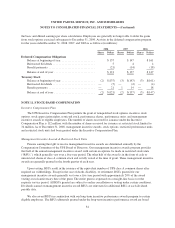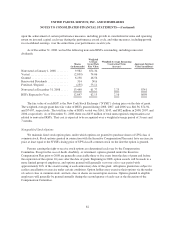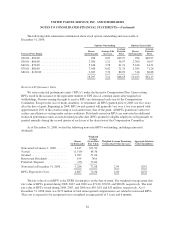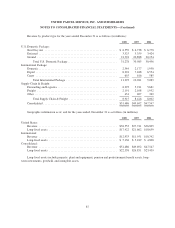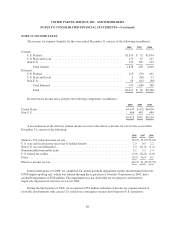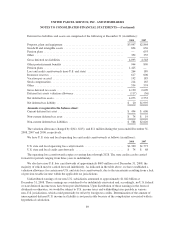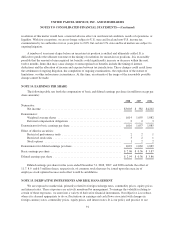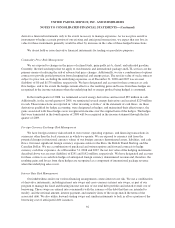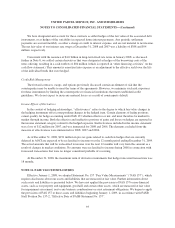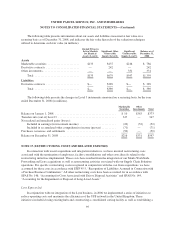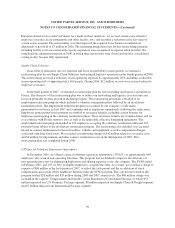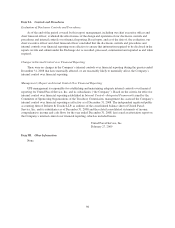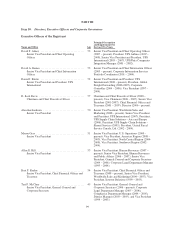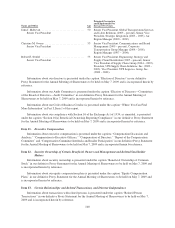UPS 2008 Annual Report Download - page 102
Download and view the complete annual report
Please find page 102 of the 2008 UPS annual report below. You can navigate through the pages in the report by either clicking on the pages listed below, or by using the keyword search tool below to find specific information within the annual report.
UNITED PARCEL SERVICE, INC. AND SUBSIDIARIES
NOTES TO CONSOLIDATED FINANCIAL STATEMENTS—(Continued)
resolution of this matter would have a material adverse effect on our financial condition, results of operations, or
liquidity. With few exceptions, we are no longer subject to U.S. state and local and non-U.S. income tax
examinations by tax authorities for tax years prior to 1999, but certain U.S. state and local matters are subject to
ongoing litigation.
A number of years may elapse before an uncertain tax position is audited and ultimately settled. It is
difficult to predict the ultimate outcome or the timing of resolution for uncertain tax positions. It is reasonably
possible that the amount of unrecognized tax benefits could significantly increase or decrease within the next
twelve months. Items that may cause changes to unrecognized tax benefits include the timing of interest
deductions and the allocation of income and expense between tax jurisdictions. These changes could result from
the settlement of ongoing litigation, the completion of ongoing examinations, the expiration of the statute of
limitations, or other unforeseen circumstances. At this time, an estimate of the range of the reasonably possible
change cannot be made.
NOTE 14. EARNINGS PER SHARE
The following table sets forth the computation of basic and diluted earnings per share (in millions except per
share amounts):
2008 2007 2006
Numerator:
Net income ....................................................... $3,003 $ 382 $4,202
Denominator:
Weighted average shares ............................................ 1,014 1,055 1,082
Deferred compensation obligations ....................................223
Denominator for basic earnings per share ................................... 1,016 1,057 1,085
Effect of dilutive securities:
Restricted performance units .........................................221
Restricted stock units ...............................................321
Stock options .....................................................122
Denominator for diluted earnings per share .................................. 1,022 1,063 1,089
Basic earnings per share ................................................. $ 2.96 $ 0.36 $ 3.87
Diluted earnings per share ............................................... $ 2.94 $ 0.36 $ 3.86
Diluted earnings per share for the years ended December 31, 2008, 2007, and 2006 exclude the effect of
11.7, 8.9, and 6.3 million shares, respectively, of common stock that may be issued upon the exercise of
employee stock options because such effect would be antidilutive.
NOTE 15. DERIVATIVE INSTRUMENTS AND RISK MANAGEMENT
We are exposed to market risk, primarily related to foreign exchange rates, commodity prices, equity prices,
and interest rates. These exposures are actively monitored by management. To manage the volatility relating to
certain of these exposures, we enter into a variety of derivative financial instruments. Our objective is to reduce,
where it is deemed appropriate to do so, fluctuations in earnings and cash flows associated with changes in
foreign currency rates, commodity prices, equity prices, and interest rates. It is our policy and practice to use
91


